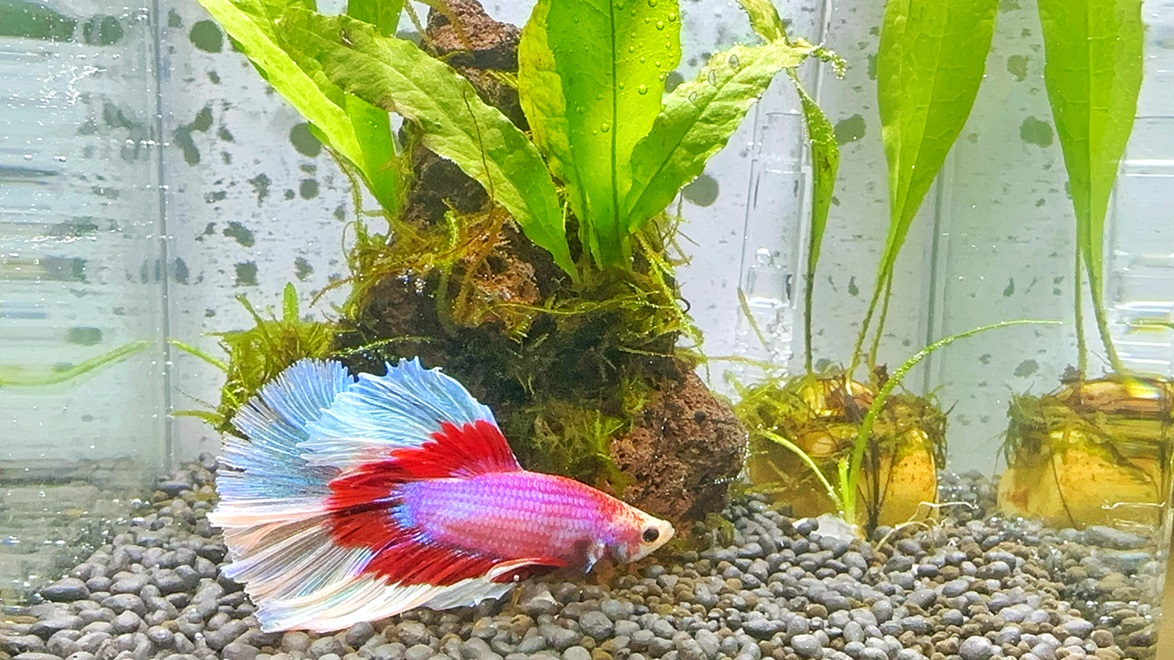Hello FishTank Community. Do you want to learn and understand the process to setup a small Betta tank at home from scratch successfully, well you have come tot he right place.
Setting up a Betta fish tank can be an exciting and rewarding experience. Betta fish, known for their vibrant colors and flowing fins, are a popular choice among aquarium enthusiasts. To ensure your Betta thrives in its new home, it’s essential to create a well-balanced and healthy environment. This guide will walk you through the entire process, from tank selection to introducing your Betta.
1. Tank Selection
The first step in setting up a Betta tank is choosing the right tank. While Bettas can survive in smaller tanks, they thrive in larger environments. A tank of at least 5 gallons is recommended. A larger tank provides more stable water conditions and more space for your Betta to explore. But as a beginner you can start a bit small in a Bowl or a tank of minimum measurements of 6x6x6 inches.
Tips:
- Opt for a tank with a lid, as Bettas can jump.
- Avoid tanks with sharp edges or decorations that can damage your Betta’s delicate fins.
2. Gravel and Soil
The substrate is an essential part of your Betta’s tank. It not only adds to the aesthetic but also provides a place for beneficial bacteria to thrive. It will also act as the base for your plants to hold the soil and grow
Gravel:
- Choose smooth, rounded gravel to prevent injury to your Betta.
- Rinse the gravel thoroughly before adding it to the tank.
- Go for Amazonia Soil for planted aqua scaping tank
Soil:
- If you plan to have live plants, consider using aquarium soil as a base layer. It provides nutrients that help plants grow.
3. Plants and Rocks
Adding plants and rocks to your Betta tank creates a more natural environment and provides hiding spots for your fish.
Live Plants:
- Anubias, Java Fern, and Marimo Moss Balls are great choices. Java moss can also be selected as the are very easy to upkeep and attach them to rocks using strings
- Live plants help maintain water quality by absorbing nitrates.
Rocks and Decorations:
- Use smooth, aquarium-safe rocks.
- Avoid sharp or rough decorations that can harm your Betta.
- Select small rocks so that he has space to grow
4. Filter Selection
A filter is crucial for maintaining clean water and a healthy environment. Betta fish prefer calm water, so choose a filter with adjustable flow settings. A small Hang-on filter will be the best which comes with speed adjustment
Tips:
- A sponge filter or a filter with a gentle flow is ideal.
- Ensure the filter is appropriately sized for your tank.
5. Water Cycling Process
Cycling your tank is vital before introducing your Betta. This process establishes beneficial bacteria that help break down harmful waste products.
Steps:
- Fill the tank with dechlorinated water.
- Add a source of ammonia (like fish food) to kick-start the cycling process.
- Test the water regularly for ammonia, nitrites, and nitrates. if you dont have the kit try smelling it for foul or pungent smell.
- The cycling process can take 1-2 weeks for big tanks. Your tank is cycled when ammonia and nitrite levels are zero, and nitrate levels are low. But for small tanks, try to cycle minimum 24 hours before introducing the fish.
- Also try to change the water every 15 days with 30% water change. Don't clear out the old water completely.
6. Beneficial Bacteria
Beneficial bacteria play a crucial role in breaking down waste products in your Betta tank. You can add these bacteria through commercial products designed to jump-start the cycling process.
Tips:
- Follow the manufacturer’s instructions when using bacterial supplements.
- Regularly test your water to ensure the bacteria are working effectively.
7. Introducing Your Betta
Once your tank is cycled, it’s time to introduce your Betta to its new home.
Steps:
- Float the Betta’s bag in the tank for 15-20 minutes to acclimate it to the water temperature.
- Slowly add small amounts of tank water to the bag every 5 minutes.
- After about 30 minutes, gently release the Betta into the tank.
8. Selecting Medicines
Having the right medicines on hand is essential for treating common Betta ailments.
Common Medicines:
- Bettafix: Helps heal minor wounds and fin damage.
- API Stress Coat: Reduces stress and promotes healing.
- Aquarium Salt: Used for treating mild infections and parasites.
- General Aid: for general medicine upkeep
Tips:
- Always follow dosage instructions carefully.
- Remove activated carbon from the filter when treating the tank with medication.
9. Food
Betta will prefer live foods but if that is not available then dried food or pellets works fine.
Tips:
- Give 3-5 pellets or tetra bits food at one time.
- Feeding 2 time is sufficient for the day
- Remember any uneaten food to avoid pollution
Conclusion
Setting up a Betta fish tank requires careful planning and attention to detail. By selecting the right tank, substrate, plants, and filter, and by properly cycling your tank, you can create a healthy and vibrant environment for your Betta. With the right care and a well-maintained habitat, your Betta will thrive and bring beauty to your home.
Feel free to reach out if you have any questions or need further assistance. Happy fish keeping!
